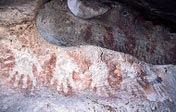Prehistoric women and men work independently
An analysis of the handprints on an Indonesian cave wall shows that men and women did not share each other's work during the art labor process.

Handprints in the cave
Experts of the French National Center for Scientific Research have studied the remains of the Gua Masri II cave in Indonesia, based on a computer model to determine which fingerprints are for men and of female.
They found a group of men with fingerprints gathering at some point, and women leaving fingerprints in other areas.
"This finding supports the theory that prehistoric men do separate activities for women," said Jean-Michel Chazine at France's Credo Center for Ocean Studies. "This result proves that women's role is much more important than previously thought."
The new software is based on the principle that the master's gender can be found based on the ratio of the ring finger and index finger. These two fingers are almost the same in women but are large in men.
Two caves Gua Masri is located in the Central Highlands of Borneo, which contains hundreds of fingerprints dating to 8,000-20,000 years old.
MT (according to AFP)
- Office women are more diligent than men
- Science proves: Prehistoric women are stronger than most modern men
- Attractive women find work easier
- Women are less seduced by stressful work
- Compare financial fun between men and women
- Work stress causes breast cancer
- Men are 'feminine' easy to achieve at work
- Working night shifts affects women's fertility
- Cromlec stone rings and legends of mystical women
- Phai should drink coffee when working
- Women find it difficult to conceive if they do night shifts
- Why shopping immersed women?
 Discovered an ancient centipede fossil 99 million years old
Discovered an ancient centipede fossil 99 million years old Discovered bat-like dinosaurs in China
Discovered bat-like dinosaurs in China Discovered a 200-year-old bronze cannon of the coast
Discovered a 200-year-old bronze cannon of the coast Discover 305 million-year-old spider fossils
Discover 305 million-year-old spider fossils Looking at beautiful men and women can help improve memory? Research reveals surprising results!
Looking at beautiful men and women can help improve memory? Research reveals surprising results!  Explaining 7 psychological behaviors about attraction, showing that beauty is not really in the eye of the beholder
Explaining 7 psychological behaviors about attraction, showing that beauty is not really in the eye of the beholder  Evidence shows that men can drive better than women
Evidence shows that men can drive better than women  Why do Russian men like to wear earrings?
Why do Russian men like to wear earrings?  New research shows: Men who want to live long should get married!
New research shows: Men who want to live long should get married!  'Beer belly' increases mortality from prostate cancer in men
'Beer belly' increases mortality from prostate cancer in men 